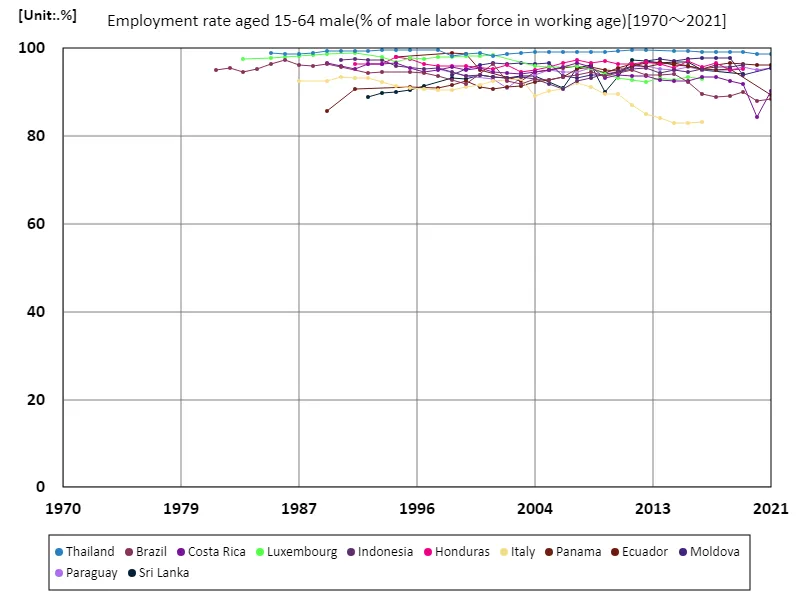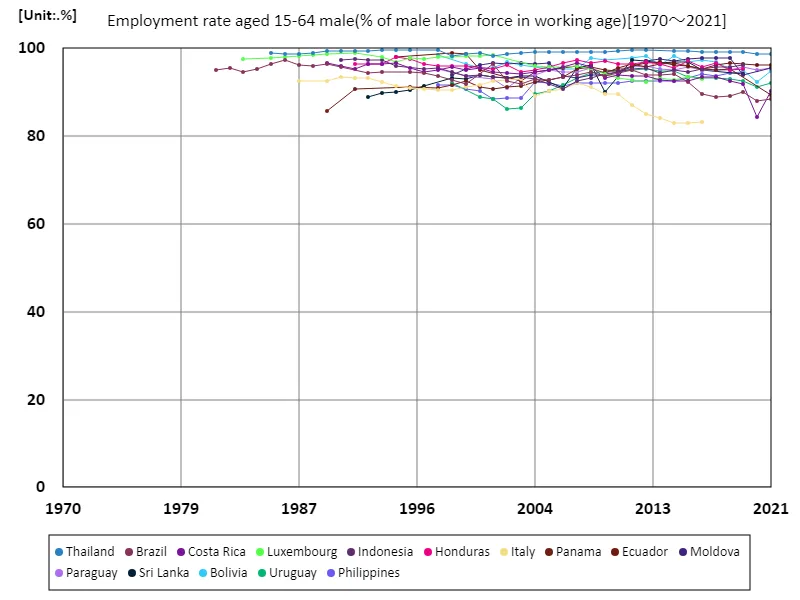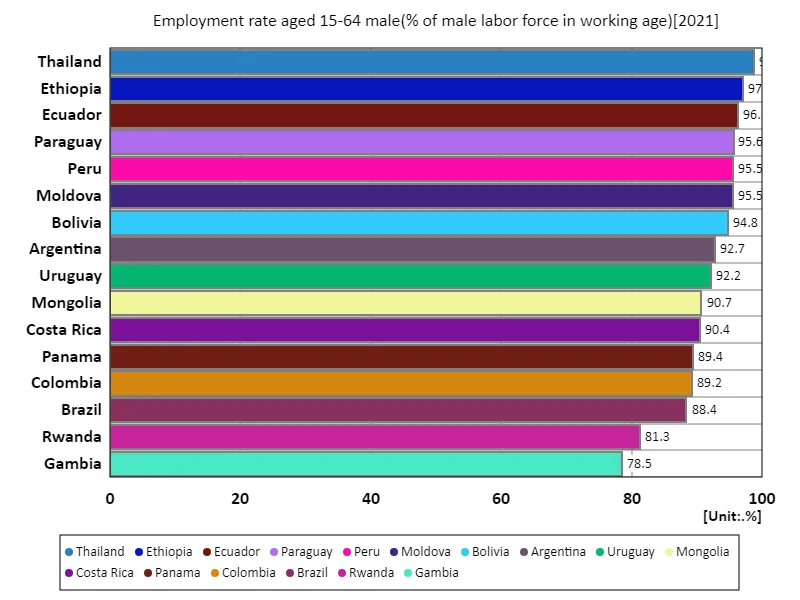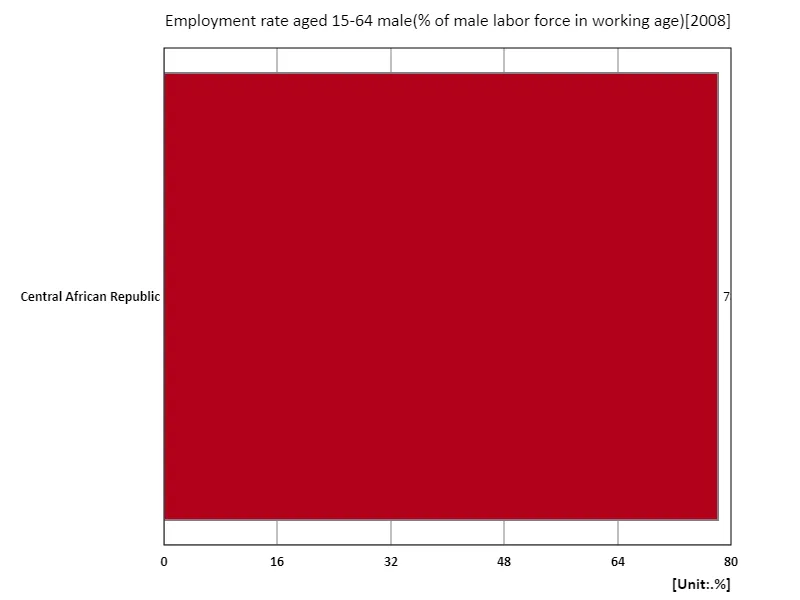- Abstract
- Employment rate of men aged 15-64 (percentage of total male labor force)
- Employment rate for men aged 15-64 (percentage of total male labor force) (worldwide)
- Employment rate of men aged 15-64 (percentage of total male labor force) (world, latest year)
- Employment rate for men aged 15-64 (percentage of total male labor force) (region, latest year)
- Reference
Abstract
It is noteworthy that, according to 2021 data, the employment rate for men aged 15-64 in Thailand has reached a high level of 98.7%. This high employment rate indicates that Thailand’s economy is relatively stable and its labour market is well-functioning. Thailand is an emerging economy that has experienced rapid growth over the years, and this growth is likely contributing to an expansion of employment opportunities. On the other hand, high employment does not necessarily mean the overall health of the economy. Other factors are also important, for example the structure of the labour market, the level of wages and the quality of the working environment. In the case of Thailand, although the employment rate has remained high in line with economic growth, there are concerns about the increase in low-wage labor and non-regular employment. Furthermore, countries with high employment rates, such as Thailand, are faced with the need to improve the quality of jobs as their economies mature. Historical data shows that while economic growth contributes to higher employment rates, improving the quality of jobs and working conditions is essential for sustainable economic development. Therefore, while Thailand’s high employment rate is a positive indicator, it needs to be evaluated alongside other economic and social factors.
Employment rate of men aged 15-64 (percentage of total male labor force)
Considering data from 1981 to 2021, the employment rate of Thai men aged 15-64 shows a notable change. In particular, the employment rate was extremely high at 99.7% in 1995, but has now declined slightly to 99%. This high employment rate reflects Thailand’s fast-growing economy and vibrant labour market. During the economic expansion period of the 1990s, rapid industrialization and increased foreign direct investment contributed to an expansion of employment opportunities. However, several factors have contributed to the subsequent fluctuations. Since the 2000s, Thailand has responded to the advancement of globalization and technological innovation, and the structure of its labor market has changed, with a particular shift from manufacturing to the service industry. This raises challenges around job quality and stability. Additionally, as the economy matures, the labor market has become more competitive, causing demand for some jobs and skill sets to fluctuate. Regional disparities and labour market imbalances may also have contributed to the slight decline in employment rates. Overall, Thailand’s high employment rate remains an important indicator of the country’s economic health, but improving job quality and working conditions remains a challenge. The example of Thailand illustrates the dynamism of the job market in fast-growing economies and the importance of responding to those changes.


The maximum is 99.7%[1995] of Thailand, and the current value is about 99%
Employment rate for men aged 15-64 (percentage of total male labor force) (worldwide)
Looking at data from 1981 to 2021, the employment rate of Thai men aged 15-64 has undergone notable changes. In particular, in 1995, the country recorded the highest employment rate in the world at 99.7%, but this has now decreased slightly to 99%. This high peak employment rate reflects Thailand’s rapid growth in the 1990s, driven by rapid industrialization and increasing foreign investment. Thailand’s economic growth has been fuelled by manufacturing and export-led industrial expansion, creating many employment opportunities. However, in the 2000s, changes in the economic structure, along with the growth of the service industry and technological innovation, had an impact on the employment market. As a result, while some high-paying jobs have increased, there has also been an increase in low-paying non-regular employment, resulting in a diversification of the quality of employment. Additionally, Thailand’s slight decline in employment rates may reflect regional economic disparities and difficulties adapting to changes in the labor market. As the employment market changes due to technological advances and international economic fluctuations, Thailand continues to maintain a high employment rate, but improving the quality of employment and working conditions is a future challenge. These changes present common challenges to other emerging economies, requiring them to respond to ensure sustainable economic growth and the development of the job market.


The maximum is 99.7%[1995] of Thailand, and the current value is about 99%
Employment rate of men aged 15-64 (percentage of total male labor force) (world, latest year)
Based on 2021 data, Thailand’s employment rate for men aged 15-64 is 98.7%, one of the highest in the world. On the other hand, the global average is 91.6%, making Thailand’s employment rate particularly high. The total value of 1.47k% represents the aggregate percentage of the total male labor force and gives an indication of the distribution of employment rates in individual countries. Thailand’s high employment rate is likely due to its strong economic growth and industrial diversification. In particular, Thailand has offered a wide range of employment opportunities through the growth of its manufacturing and service sectors. The background to this is an increase in international investment and an expansion of the domestic market. Thailand’s fast-growing economy and vibrant labour market have helped it maintain a high employment rate. However, Thailand’s high employment rate also comes with challenges. There are issues such as employment quality, wage disparities, and an increase in non-regular employment. Improving employment stability and working conditions will be important issues going forward. While the global average is 91.6%, employment rates vary widely across regions and countries, making these data an important indicator when assessing the health of an economy and the state of the labor market.


The maximum is 98.7% of Thailand, the average is 91.6%, and the total is 1.47k%
Employment rate for men aged 15-64 (percentage of total male labor force) (region, latest year)
According to 2008 data, the Central African Republic has the highest employment rate among men aged 15-64 at 78.1%, while the global average is also 78.1%. This result reflects the specifics of the Central African Republic’s labour market, but it is also interesting to note that the average value shown in the data is also recorded as the maximum value. The high employment rate in the Central African Republic can be attributed to the characteristics of the local economy and the structure of the labour market. For example, traditional economic activities such as agriculture and handicrafts are at the forefront, and these sectors offer a wide range of employment opportunities. It is also possible that the informal sector of the labour market has a large influence. Where the informal economy dominates, employment rates may be relatively high. However, a high employment rate, such as in the Central African Republic, is not necessarily an indication of a healthy economy or good working conditions. In many regions, high employment rates reflect the widespread nature of workers, with limited formal employment opportunities. This means that even if employment rates are high, there may be underlying issues such as low wages and lack of job security. Overall, it is important to understand that high employment rates do not necessarily equate to economically prosperous situations.


The maximum is 78.1% of Central African Republic, the average is 78.1%, and the total is 78.1%



Comments